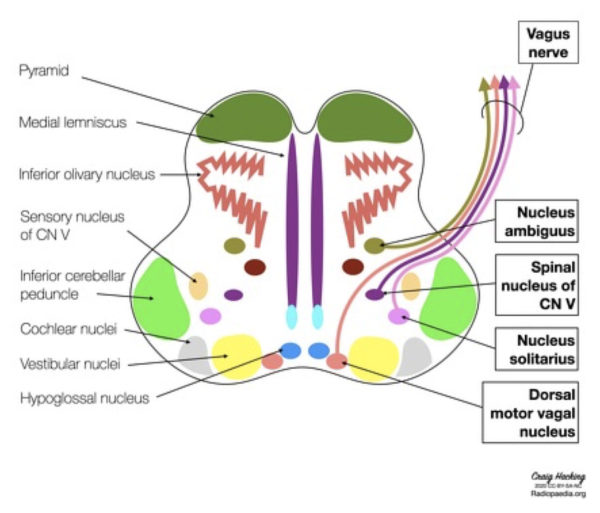A simple Google Scholar query using “Polyvagal” will come up with several thousand articles and the foundational papers have been cited about 15,000 times. The following provides a selection of articles in scientific publications related to the Polyvagal Theory.
There is no controversy that there are two different vagal pathways. This is well documented in the original statement of the theory in 1995 and updated in 2007:
Orienting in a defensive world: Mammalian modifications of our evolutionary heritage. A Polyvagal Theory. (Presidential Address to the Society for Psychophysiological Research, 1994; published 1995 in Psychophysiology, a Cambridge University Press publication).
The polyvagal perspective (published 2007 in Biological Psychology, an Elsevier publication).
The paper has two objectives: first, to provide an explicit statement of the theory; and second, to introduce the features of a polyvagal perspective. The polyvagal perspective emphasizes how an understanding of neurophysiological mechanisms and phylogenetic shifts in neural regulation leads to different questions, paradigms, explanations, and conclusions regarding autonomic function in biobehavioral processes than peripheral models. Foremost, the polyvagal perspective emphasizes the importance of phylogenetic changes in the neural structures regulating the autonomic nervous system and how these phylogenetic shifts provide insights into the adaptive function and the neural regulation of the two vagal systems.
Also: The diagram below, based on medical imaging, shows that there are distinct brainstem sources of pathways “traveling” through the vagus. One of them is for the dorsal motor vagal nucleus. The others are for the Ventral Vagal. The nucleus solitarius is the sensory nucleus of the vagus.

Royal Brisbane and Women’s Hospital & Radiopaedia.org
The following articles provide recent perspectives on the Polyvagal Theory.
Polyvagal Theory: A biobehavioral journey to sociality (published 2021 in Comprehensive Psychoendocrinology, an Elsevier publication)
See highlighted section of p.4 of the PDF: “Polyvagal Theory: a testable solution of the vagal paradox”
Polyvagal Theory: A Science of Safety (published 2022 in Frontiers in Integrative Neuroscience).
The study of feelings of safety has been an elusive construct that has historically been dependent upon subjectivity. (…) Polyvagal Theory provides an innovative scientific perspective to study feelings of safety that incorporates an understanding of neuroanatomy and neurophysiology.
The developmental model focusing on embryological changes that parallel the phylogenetic shifts is also well documented in a 2011 paper. See also a recent publication about the Safe and Sound Protocol (SSP) in the Harvard Review of Psychiatry.
The Early Development of the Autonomic Nervous System Provides a Neural Platform for Social Behaviour: A Polyvagal Perspective (published 2011 in Infant and Child Development, a Wiley publiation).
Neuromodulation Using Computer-Altered Music to Treat a Ten-Year-Old Child Unresponsive to Standard Interventions for Functional Neurological Disorder (published 2022, Harvard Review of Psychiatry)
The ‘theory’ part of PVT is related to the predictions related to mental and physical health. The theory is gaining traction in gastroenterology.
An Evolutionary Medicine Perspective on Treatment of Pediatric Functional Abdominal Pain (published 2020 in American Journal of Gastroenterology). See highlighted sections in the PDF.
The following articles describe recent research that tested the theory with adversity history.
Childhood Maltreatment Influences Autonomic Regulation and Mental Health in College Students (published 2022 in Frontiers in Psychiatry).
Consistent with prior literature, there were significant associations between maltreatment history and autonomic reactivity (i.e., heart rate and respiratory sinus arrhythmia) during emotional and physical challenges; however, when VE (Vagal Efficiency) was entered as a covariate these associations were no longer statistically significant. Blunted VE may reflect a neural pathway through which maltreatment retunes autonomic regulation and provides a neurophysiological platform that increases mental health risk.
Increased Autonomic Reactivity and Mental Health Difficulties in COVID-19 Survivors: Implications for Medical Providers (published 2022 in Frontiers in Psychiatry)
The article describes a study testing the following hypothesis: Polyvagal theory would suggest that individuals more impacted by their prior adversities would be more vulnerable to and impacted by the COVID-19 virus, and that their COVID-19 infection exacerbating their prior vulnerabilities and leading to more MH difficulties (i.e., emotional distress, mindfulness difficulties, and posttraumatic stress symptoms). Specifically, the increased autonomic reactivity associated with their prior adversity and the COVID-19 infection would be associated with greater negative MH difficulties.
Adversity History Predicts Self-Reported Autonomic Reactivity and Mental Health in US Residents During the COVID-19 Pandemic. (published 2020 in Frontiers in Psychiatry).
The data highlight the important role of autonomic regulation as an intervening variable in mediating the impact of adversity on mental health.
See also the following paper by Stephen Porges (February 2023):
– Polyvagal Theory: Summary, Premises & Current Status (PDF)
– Abridged version of the above paper